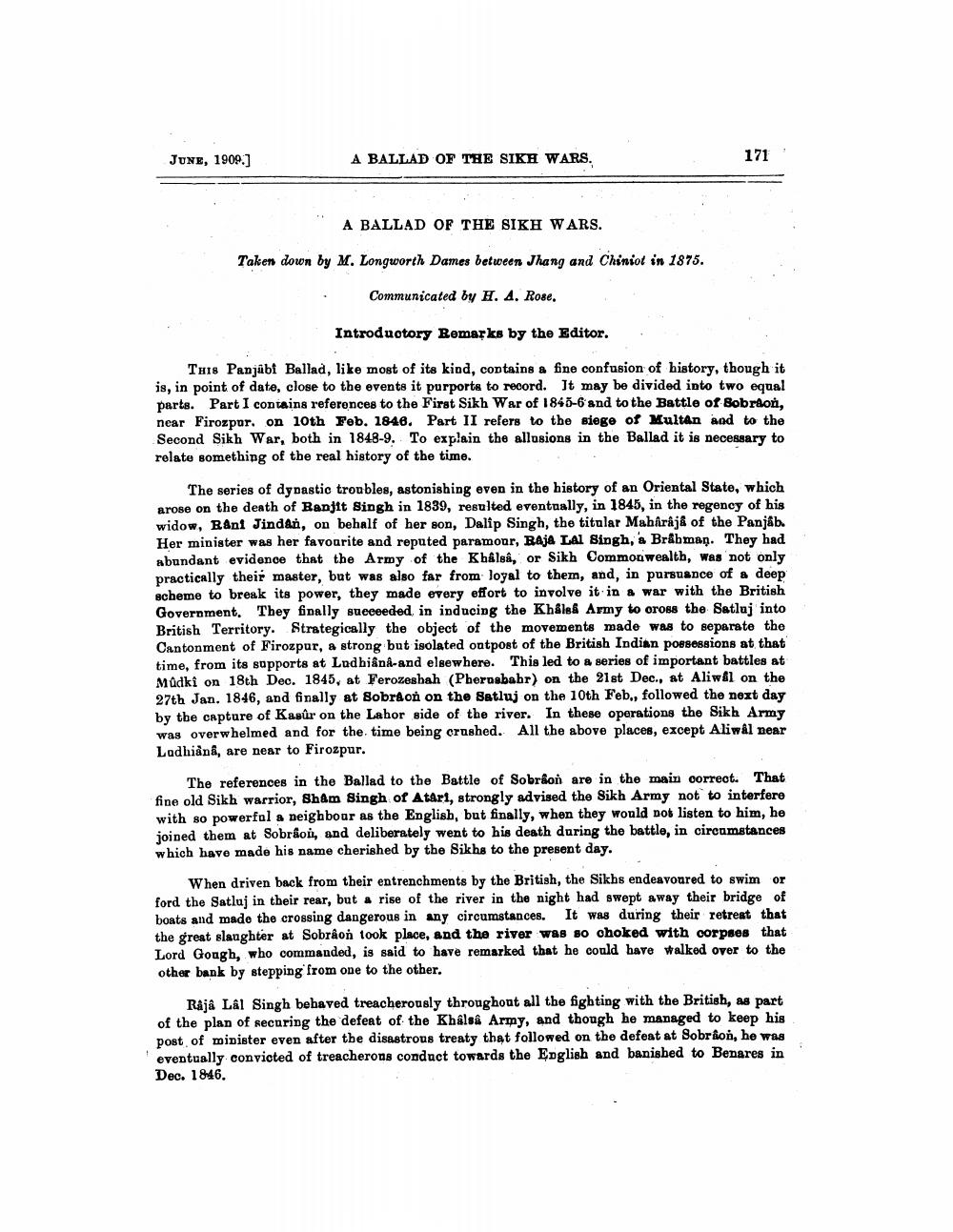________________
JUNE, 1909.]
A BALLAD OF THE SIKH WARS.
171
A BALLAD OF THE SIKH WARS.
Taken down by M. Longworth Dames between Jhang and Chiniot in 1875.
•
Communicated by H. A. Rose.
Introductory Remarks by the Editor.
Tus Panjâbf Ballad, like most of its kind, contains a fine confusion of history, though it is, in point of date, close to the events it purports to record. It may be divided into two equal parts. Part I contains references to the First Sikh War of 1845-6 and to the Battle of Bobraon, near Firozpur. on 10th Feb. 1846. Part II refers to the siege of Multan and to the Second Sikh War, both in 1848-9. To explain the allusions in the Ballad it is necessary to relato something of the real history of the time.
The series of dynastio troubles, astonishing even in the history of an Oriental State, which arose on the death of Ranjit Singh in 1839, resulted eventually, in 1845, in the regency of his widow, Rani Jindan, on behalf of her son, Dalip Singh, the titular Maharaja of the Panjab Her minister was her favourite and reputed paramour, Raja LAI Singh, a Bråbman. They had abundant evidence that the Army of the Khalsa, or Sikh Commonwealth, was not only practically their master, but was also far from loyal to them, and, in pursuance of a deep scheme to break its power, they made every effort to involve it in a war with the British Government. They finally succeeded, in inducing the Khaled Army to cross the Satluj into British Territory. Strategically the object of the movements made was to separate the Cantonment of Firozpur, a strong but isolated ontpost of the British Indian possessions at that time, from its supports at Ludbiânâ-and elsewhere. This led to a series of important battles at Můdki on 18th Dec. 1845, at Ferozeshah (Pherasbabr) on the 21st Dec., at Aliwfl on the 27th Jan. 1846, and finally at sobraon on the Satluj on the 10th Feb., followed the next day by the capture of Kasur on the Lahor side of the river. In these operations the Sikh Army was overwhelmed and for the time being crushed. All the above places, except Aliwal near Ladhiana, are near to Firozpur.
The references in the Ballad to the Battle of Sobraon are in the main correct. That fine old Sikh warrior, Sham Singh of Atari, strongly advised the Sikh Army not to interfere with so powerful a neighbour as the English, but finally, when they would not listen to him, he joined them at Sobraon, and deliberately went to his death during the battle, in circumstances which have made his name cherished by the Sikhs to the present day.
When driven back from their entrenchments by the British, the Sikhs endeavoured to swim or ford the Satluj in their rear, but a rise of the river in the night had swept away their bridge of boats and made the crossing dangerous in any circumstances. It was during their retreat that the great slaughter at Sobrâon took place, and the river was so choked with corpses that Lord Gough, who commanded, is said to have remarked that he could have walked over to the other bank by stepping from one to the other.
Raja Lal Singh behaved treacherously throughout all the fighting with the British, as part of the plan of securing the defeat of the Khâlsân Army, and though he managed to keep his post of minister even after the disastrous treaty that followed on the defeat at Sobrion, he was eventually convicted of treacherons conduct towards the English and banished to Benares in Dec. 1846.




